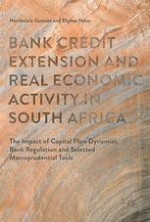2017 | OriginalPaper | Chapter
11. Adverse Credit Supply Shocks and Weak Economic Growth
Authors : Nombulelo Gumata, Eliphas Ndou
Published in: Bank Credit Extension and Real Economic Activity in South Africa
Publisher: Springer International Publishing
Activate our intelligent search to find suitable subject content or patents.
Select sections of text to find matching patents with Artificial Intelligence. powered by
Select sections of text to find additional relevant content using AI-assisted search. powered by
Abstract
-
• Know the benefits of using the pure sign restriction and penalty function sign restriction approaches in VAR
-
• Distinguish between adverse credit supply effects, tighter monetary policy and adverse credit demand shocks on lending spreads, GDP and credit growth
-
• Show that adverse credit supply shock is partly responsible for the weak economic growth recovery and elevated loan spreads
-
• Determine the role of global economic uncertainty shocks on elevated lending spreads
